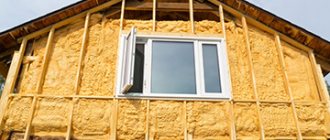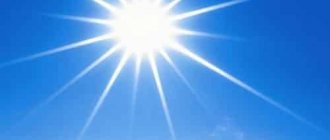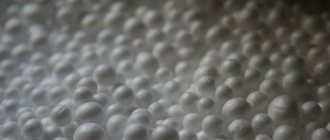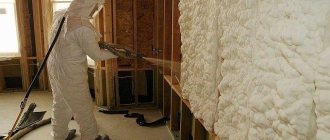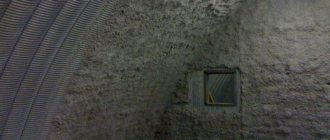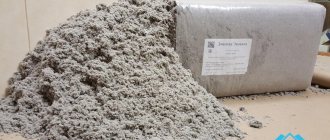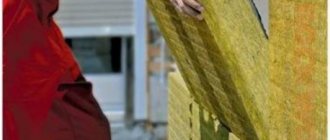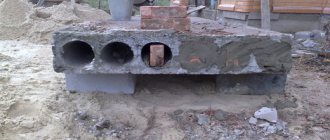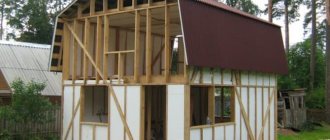The modern construction market offers developers a huge amount of thermal insulation materials. This article is entirely devoted to ecowool - a natural insulation based on cellulose.
The relevant sections will discuss the advantages and disadvantages of this material, its scope and features of its application. At the end of the article you can find a list of leading ecowool manufacturers and reviews from home owners who have assessed the advantages and disadvantages of modern insulation in practice.
What is ecowool?
Ecowool is an insulation material consisting of cellulose and special additives (fire retardants and antiseptics). Most often, borax acts as a fire retardant, and boric acid provides high antiseptic properties.
Borax minimizes the likelihood of a fire. Boric acid prevents the appearance of mold and other fungal colonies, and also repels insects and rodents.
Despite the loose structure, which provides high thermal insulation properties, the material has good mechanical characteristics. Despite the fact that the material is not widely used in mass construction, it is actively used in private development.
Important! Mineral wool, unlike ecowool, does not contain boric acid, so it is often damaged by insects and rodents.
Composition, properties and characteristics of ecowool
Ecowool consists of 80% cellulose fibers. The material is not fire-resistant, moisture-resistant and is easily susceptible to biological influence. It is for this reason that the insulation contains special additives that eliminate these shortcomings.
Borax is most often used as a fire retardant. This substance significantly increases the fire resistance of insulation and reduces the likelihood of a fire. Despite this, ecowool cannot be used for thermal insulation of chimneys and other hot objects.
Boric acid, which is part of ecowool, acts as an antiseptic. The presence of this component eliminates rotting, prevents the development of fungal colonies, and repels insects and rodents.
The standard release form is a bag weighing 15 kg. The density of the compressed material is 110 kg/m3, however, after processing using an electric drill with a special attachment, the volume of insulation increases more than three times.
The performance characteristics of ecowool are given in the table:
| Parameter name | Meaning |
| Thermal conductivity coefficient, W/mK | 0,038-0,041 |
| Vapor permeability, mg/mchPa | 0,3 |
| Air permeability, m3/m2Pa | 0,0001 |
| Flammability | Moderate |
| Noise absorption per 5 cm thickness, dB | 63 |
| Specific gravity, kg/m3 | 25-96; varies during installation |
Do-it-yourself ecowool installation
In order to insulate a house with your own hands, you will need a certain set of tools:
- Ecowool
- Beam for the frame.
- Windproofing film.
- Scotch tape or oilcloth for sealing technological holes.
- Garden vacuum cleaner. Enough power 2 thousand. Watt.
- Corrugated hose of the desired length, with a diameter of at least 7 mm.
- Rag ring along the diameter of the hose to limit dust emissions.
- Drill with stirring attachment.
- A trough, basin, box or other capacious container for fluffing ecowool.
- Electric trimming roller for removing excess pulp. The necessary tools can be purchased at a hardware store or rented from a company that provides this type of service to the public.
Insulation and its main stages
- ecowool insulation
- Scotch tape for sealing holes (used more often for interior decoration)
- Vacuum cleaner with a power of at least 2000 watts
- Drill with attachment for fluffing ecowool
Insulating the facade on your own will require a step-by-step implementation of actions.
- Before you start installing ecowool, you need to choose one of the methods of insulating walls with ecowool.
- The house is “sheathed” with a wooden or metal frame.
- A windproofing film is attached to the frame if the intended laying layer is large, 7-10 cm or more. With a thin layer of 3-5 cm, the material can be laid without film.
- Holes are made in the film or other building material, for example, OSB, to the diameter of the corrugated hose.
- Cellulose is supplied from the manufacturer in compressed form, so before laying it must be “fluffed” - broken into fibers. To do this, pour cellulose from a bag into a special container and mix it thoroughly using a drill with a mixer attachment.
It is important to know
When fluffing, the volume of cellulose increases two to three times.
On a garden vacuum cleaner, one part is removed and the terminals from it are moved to another part. Otherwise, the vacuum cleaner will not turn on, and the long trunk will not have enough suction power. The opening of the dust collector is connected to a corrugated hose and secured with tape at the junction. A ring made of any material is put on the other end of the hose
During operation, it will serve as a limiter for dust emissions. The vacuum cleaner is connected to speed 3-4, the trunk of the vacuum cleaner is lowered into the hole, and the ecowool is carefully suctioned. As the cavity fills with material, the vacuum cleaner stops and the pulp is compacted manually. The final stage is sealing the holes and eliminating excess ecowool.
Pros and cons of ecowool
Any building material has its advantages and disadvantages. The question is what is more? The undeniable advantages of insulation include:
- high thermal insulation properties, however, the thermal conductivity of the material may be influenced by operating conditions and compliance with installation technology;
- monolithic structure. With proper installation, the appearance of tears and joints is excluded, which has a positive effect on the energy efficiency of insulation as a whole;
- high sound insulation rates. Ecowool allows you to reduce the noise level by half or more;
- resistance to moisture. This property is due to the high vapor permeability of the material and its structure;
- environmental safety. The insulation does not contain toxins and other harmful substances that pose a danger to humans and the environment;
- resistance to biological influences. Thanks to the boric acid contained in ecowool, the material does not rot, does not attract insects and rodents, and does not create favorable conditions for the development of mold and fungal colonies;
- high degree of fire safety. The composition includes borax, which is an effective fire retardant;
- long service life. If all operating rules are followed, the insulation can last up to 60 years;
- affordable price. Considering the fact that ecowool is produced from paper industry waste and waste paper, the cost of the material is quite affordable for most private developers.
The following points can be considered as significant disadvantages of ecowool:
- lack of stability in the thermal insulation layer. This unpleasant phenomenon can occur as a result of shrinkage of the material or uneven laying;
- using the manual method, you can only insulate open horizontal areas (floors and attic floors). To insulate other surfaces, special expensive equipment will be required;
- When laying wet, the installation time increases significantly. Although wet installation ensures high quality installation, complete drying of the material takes at least 3 days;
- insufficient rigidity. It will not be possible to make a screed on a floor insulated with ecowool without a frame;
- need for protection against overheating. Despite the fact that it contains borax, to ensure fire safety, the insulation is protected from overheating with asbestos-cement sheets.
Ecowool application technology
There are two ways to apply the material:
- manual;
- automated.
Both manual and automated application methods have their advantages and disadvantages. Let's consider both methods in detail.
Manual method
With the manual method, insulation is carried out in several stages:
- The required amount of material is poured into a specially prepared container. In construction stores, ecowool is presented in a compressed state, so before starting work, you need to beat the semi-finished product. This is done using an electric drill with a special attachment. During this event, the volume of material increases more than three times. This fact must be taken into account when choosing a container.
- The next step is pouring fluffy wool into the floor, ceiling or vertically oriented structures. At this stage, special attention must be paid to the packing density of the material, which can differ significantly for different structural elements.
The table shows the recommended laying density of ecowool for various elements of building structures.
| Insulation object | Recommended density, kg/m3 |
| Insulation of floors | 35-50 |
| Wall insulation | up to 60 |
| Roof insulation | 50 |
Important! The manual method is not suitable for insulating large areas. In this case, it is advisable to use special blow molding equipment.
Automated method
Automated installation of ecowool is carried out using the following special equipment:
- automatic blow molding unit equipped with a special baking powder. With its help, the material is supplied uniformly to its destination;
- corrugated pipelines through which ecowool is supplied to the work site;
- water-adhesive installation involves the use of a set of special pumps;
- for wet application of the material, an additional set of elements is included in the delivery package;
- The most modern installations for applying ecowool involve the use of special blowing nozzles and electric trimming rollers, with the help of which excess material is removed.
Automated method of internal wall insulation
Wall insulation is carried out in the following sequence:
- A hole is drilled in the upper part of the wall corresponding to the diameter of the supply pipe.
- The supply pipe is inserted into the hole made, after which the supply equipment is turned on.
- The cavity between the base and the finishing is gradually filled with dry mass.
- The last step is to seal the hole.
Weather conditions do not affect the blowing of voids. Insulation can be done without dismantling the structure. Despite these advantages, there is one disadvantage. The fact is that it is almost impossible to control the uniform distribution of insulation in the cavity. In some cases, this can lead to a weakening of the thermal insulation properties.
Ecowool floor insulation
The technology of floor insulation is much simpler than the technology of wall insulation. The work is carried out in the following sequence:
- The base is leveled and the logs are laid. The optimal log height is 80 mm. The overall dimensions of the cells are approximately 400x800 mm.
- The briquette is poured into a previously prepared container, where it is thoroughly mixed using an electric drill with a special mixer attachment.
- The space between the joists is filled. The insulation should protrude slightly above the surface of the lag; a small excess of material is subsequently compressed with the rough flooring.
Important! Insulating the floor with ecowool in the basement is impractical due to high humidity.
Roof insulation with ecowool
The dry method is also used to insulate the roof. A vapor barrier or special durable parchment is placed on the rafters. Holes are made in this covering through which the cavities are filled with insulation.
When insulating the attic, at the first stage the rafters are sheathed with finishing material. After this, holes are made in the casing through which the cavities are filled with ecowool.
The main disadvantage of this method is the lack of control over the filling of cavities. This can lead to the formation of voids and uneven filling of the space between the attic finish and the base. In addition, when insulating a roof, two points are necessary:
- the density of ecowool should not exceed 35 kg/m3;
- If corrugated sheeting or metal tiles are used as roofing material, waterproofing work must be carried out before proceeding with insulation.
Ecowool - disadvantages of insulation
It was decided to start with the shortcomings, in order to then emphasize the characteristics for which this insulation is increasingly appearing in our homes. The main inconvenience is associated with the consistency of ecowool, because this type of insulation is not sold in the usual and convenient rolls or molded tiles. Therefore, laying it with one’s own hands is practically impossible; a qualified team with special equipment is needed.
Ecowool is supplied in packages in the form of loose powder; it is loaded into a machine, with the help of which it is blown into cavities for insulation or sprayed, while being moistened with water. Of course, you can try to imitate the operation of a mechanical tool yourself, but only on simple surfaces. And in this case, you will also encounter the main drawback - dustiness.
Another circumstance that arises from the low density of ecowool is the impossibility of creating a “floating” floor. Surely you have heard this term, which means that the floor covering on which you will move is not strictly connected to the structure of the building. This is done to prevent floor deformation during building shrinkage or to ensure safety in earthquake-prone areas. So, the looseness of ecowool is fraught with a lot of inconvenience as an underground insulation between the building frame and such a “floating” floor.
Methods of insulation with ecowool
There are three ways to apply insulation to the insulated surface:
- dry;
- wet;
- wet-adhesive.
Let's look at each of these methods in detail.
Dry application of ecowool
This method is optimal for thermal insulation of horizontal and inclined surfaces. Most often, dry filling is used when filling confined spaces and insulating interfloor ceilings.
Application of ecowool using the dry method is carried out in two stages:
1. A hole is drilled in a confined space, the diameter of which clearly corresponds to the diameter of the supply corrugated hose.
2. The supply pipe is inserted into the hole and ecowool mixed with air is fed into the cavity. Air makes it possible to effectively deliver insulation to the most remote areas and contributes to maximum filling of the cavity with insulation. The feed continues until its density reaches the required value.
When applied horizontally, there is no need for preliminary insulation, which significantly speeds up installation work.
Wet application of ecowool
The wet method is used when insulating open vertical surfaces. As the name of the method implies, ecowool is pre-moistened before application to the insulated surface. Lignin, which is part of the insulation, when interacting with water, acquires adhesive properties, which promotes a tight fit of the material to the base. At the final stage of work, the material protruding beyond the frame is cut off with an electric trimming roller.
Wet-adhesive application
This method differs from the wet method in that, in addition to moistening the material during the application process, a special adhesive component is added to the ecowool. The presence of this substance in the insulation improves performance characteristics:
- the likelihood of cotton wool deforming after drying is reduced;
- The elasticity of the insulation increases significantly.
The wet-adhesive method is used for thermal insulation of horizontal planes, access to the lower part of which is impossible or difficult. Examples of such surfaces include various suspended structures.
Methods of use
Ecowool is the thermal insulation of walls and sound insulation of the entire room. Ecowool is used as a thermal insulation material in the following cases:
- in the construction of apartment buildings and private ones in the formation of floors;
- insulation in all frame structures;
- for warm plaster;
- for multi-layer wall insulation;
- for the reconstruction of an old building.
Since wall insulation is only one way to use ecowool, the following insulation options are distinguished:
- it is recommended to use insulation as a soundproofing material in the construction of apartment buildings and private buildings in ceilings and walls;
- ecowool is used as part of sound-absorbing plaster;
- in any partition walls.
It should be noted that roof insulation with ecowool is used both to increase heat and to absorb sound. There are two ways to use the insulation in question - wet and dry.
The wet method is an industrial method that uses a special blowing machine to spray ecowool. Recommended for use on brick or block walls. During the work, a dense layer is formed - about 60 kg/cub.m. The material is pre-wetted with water or a special adhesive lignin. The application method is fast, but there is a drawback in the form of the mandatory use of expensive blow molding equipment for blowing ecowool.
The dry method is a manual method of insulating walls and roofs, where the wool is spread out by hand or with a compressor. The method is used to insulate or improve sound insulation of small buildings, including private houses. First, the material is fluffed up with a drill with a solution attachment until the volume increases 3-4 times, as mentioned above.
Rules for applying ecowool
If installation is carried out independently, it will be useful to remember a few simple rules:
- An online calculator, which can be found on any construction site, will help you correctly calculate the required number of 15-kilogram packages.
- When applying the material, the following should be taken into account: the optimal insulation thickness for the floor is 15-20 cm, for a sloping roof - 15-20 cm, for floors between floors - 10-15 cm, for attic insulation - 20-30 cm.
- You should purchase material with a reserve of 10-15% for unforeseen circumstances.
- The performance properties of ecowool are designed for insulation of wooden structures. In this case, the material can be applied to the surface without any insulation. If a metal, concrete or brick surface is insulated, insulation is required. Otherwise, condensation may accumulate in the room.
- When insulating high vertical planes, in order to avoid shrinkage of the material under its own weight, transverse dividing partitions should be provided in the frame.
- When thermally insulating the roof, it is necessary to completely eliminate the possibility of condensation forming on the inside of the roof deck.
Compliance with these simple rules will ensure coziness and a comfortable microclimate in your home.
The best ecowool manufacturers
Currently, a large number of large and small enterprises are engaged in the production of insulation. Below are the most famous manufacturers.
Isofloc
A German company specializing in the production of universal building materials and various insulation materials, in particular ecowool.
Termex
A Finnish corporation that focuses on the quality and environmental safety of its products. High quality is successfully combined with an affordable price.
Ecovilla
The products of this enterprise have become widespread due to their high quality, affordable price and environmental safety.
Ecowool Extra
A domestic company was one of the first to launch the production of ecowool in Russia. The company's products meet all the requirements of international standards, while the cost of manufactured products is significantly lower than that of foreign analogues.
Greenfiber
An American company that uses the latest technologies, thanks to which the company's products are characterized by high performance characteristics and a long service life.
Equator
A Russian company specializing in the production of a wide range of building materials. The company's products meet all international standards, are of high quality and affordable.
Among domestic manufacturers you can also find Nanovata. These enterprises may well compete with leading Western manufacturers.
What is the fire safety of insulation?
In GOST 30244 standards, all thermal insulation materials are assigned safety categories in case of fire. For example, Ecowool
meets the requirements of the fire certificate:
• G2 – moderately flammable heat insulator
• D2 – moderate smoke production
• B2 – moderately flammable material
• RP1 – zero flame propagation
The most dangerous substances for humans are the toxic substances released from the insulation, which lead to suffocation or death. If the material supports and spreads fire, property suffers, the building will burn down before the fire truck arrives, and the cottage will have to be rebuilt.
Only two heat insulators have zero flammability:
• expanded clay – inconvenient for an individual developer, since the minimum layer thickness to reduce heat loss inside the building envelope is 20 cm
• basalt wool – when wet, it almost completely loses its properties, so high-quality vapor barrier of walls, ceilings, and roofs is necessary
Figure 2. Fire resistance of Ecowool is higher than that of other insulation materials
The given fire safety characteristics of Ecowool fully meet the requirements of SP standards. The material optimally combines quality and cost.
Is it possible to make ecowool yourself?
Considering the fact that the main component of the material is cellulose, it is quite possible to make insulation at home. Of course, the performance properties of homemade ecowool will be far from the factory specifications, but it is quite suitable for insulating a garage or a rarely visited country house.
The raw material for insulation can be any paper waste. You can use old newspapers, magazines, corrugated cardboard and other waste paper.
To produce ecowool at home, first of all, you need to make a chopper. The device works on the principle of an ordinary coffee grinder, the only difference is in size.
An old washing machine can serve as the optimal base for such a device; you just need to replace the activator with a system of knives fastened together and select the required electric motor power.
After the waste paper has been properly crushed, the resulting substance is impregnated several times with solutions of boric acid and borax, and then dried.
Features of insulation of ecowool wooden houses
This type of insulation is widely used in the construction of wooden houses. The material is completely environmentally friendly. Thanks to its unique ability to breathe, ecowool allows you to maintain a comfortable microclimate inside a wooden house.
As mentioned above, installation of ecowool is possible on various coatings, including on a wooden base. At the same time, experts recommend pre-coating wooden surfaces with a primer. This will improve adhesion between the wood and the insulation.
If you follow all the work technology, insulating a wooden house with ecowool will allow you to get a warm and cozy home. It is necessary to take into account the fact that when applying ecowool to rounded and laminated timber, the consumption of insulation will be different. Ecowool is applied to a perfectly flat surface of laminated veneer lumber and easily compacted to the required density.
Insulating a house made of ecowool timber involves greater consumption of material. In some cases, the increase in material consumption can be 15-20%.
After application and compaction, you must wait until it hardens completely. Only after this can you begin the final stage of work on leveling the coating. The top insulation is covered with special kraft paper. This wrapping paper can be used for dry and wet insulation.
On top, a layer of sulfate cellulose, which is the croft base, is plastered. The finishing decorative coating is installed directly onto the plaster. Insulation of the attic with ecowool is carried out using a similar technology.
At first glance, it may seem that there is no difficulty in working with ecowool when insulating a private wooden house. However, in reality, this material has certain features in use, which can only be calculated by an experienced professional. Therefore, we do not recommend that you skimp on the quality of finishing work and entrust the insulation to specialists.
The cost of brigade services today is not too high. And with the right choice of performers, you can get a warm and comfortable room.
Ecowool or basalt insulation, which is better?
In order to answer this question, it is necessary to compare the advantages and disadvantages of both insulation materials. For ease of perception, we summarize the data in tables. Table 1 shows the pros and cons of ecowool, and table 2 of basalt insulation.
Table 1
| Advantages | Flaws |
| High thermal insulation properties. | Over time, thermal conductivity increases, and thermal insulation properties decrease. |
| Has a high level of sound insulation. | During operation, a significant decrease in the volume of the material occurs (ecowool loses up to 20% of its original mass). |
| Insulating a room requires little material (per 1 m3 from 28 to 65 kg). | It is recommended to lay ecowool with a margin of 20-25%. |
| Without toxic substances that can cause allergies or skin diseases in humans. | Absorbs quite a lot of moisture (from 9 to 15%), increased humidity increases thermal conductivity. |
| It is easy to install in hard-to-reach places. | The thermal insulation layer must be ventilated. |
| Excellent combination of price and quality | Installation of ecowool is carried out using special equipment (pneumatic inflatable device). This can only be done by specialists with extensive experience. |
| It protects a person well from harmful substances that emit polystyrene foam, fiberglass, and asbestos. | With the wet installation method, ecowool takes a long time to dry (it will take from 48 to 72 hours). This creates significant inconvenience, especially if the work needs to be completed in a short time. However, this method is of higher quality than dry installation and provides excellent thermal and sound insulation of the building. |
| Long period of operation. | It cannot be used for independent frameless insulation of screeds due to insufficient rigidity. |
| Ecowool has good adhesion to any materials. | Ecowool should not be used near fireplace pipes, open fire sources, or chimneys. It will slowly smolder from high temperatures or require additional protection in the form of a fire-resistant mat with a foil surface or asbestos-cement boards. |
table 2
| Advantages | Flaws |
| Keeps its shape well, does not fall off or sag. | The material is heavier than polystyrene foam and other mineral wools. A strong frame is required for installation. |
| Aggressive environments do not affect the density and structure of the material. | Binding resins slightly degrade environmental performance, but with proper installation and exterior finishing, this impact is almost imperceptible. |
| It is easy to work with, the material can be cut or sawed perfectly with a regular saw. | More expensive than other insulation materials. |
| There are no formations of fungi and mold on it. Microorganisms do not grow on the insulation, since its composition is not organic. | |
| It is practically of no interest to rodents. | |
| It does not burn in case of fire, since the melting point of basalt is above 1000 0C. The binder can only melt, but it is also not flammable. | |
| The insulation is not dusty. | |
| Made from natural material. | |
| It is completely chemically inert. | |
| When working with it, allergic reactions and skin irritation do not occur. | |
| A huge plus is vapor permeability. Thanks to the structure of the material, excess moisture leaves the building and condensation does not accumulate on the structures. There will be no dampness, the wooden elements of the building will not rot, and the metal elements will not undergo corrosive processes. | |
| A long period of operation, practically the same as the main structural elements of the building. | |
| If installed correctly, it does not require replacement. |
Based on the above data, the following conclusions can be drawn:
- Basalt insulation is superior to ecowool in almost all respects.
- Ecowool is much cheaper than basalt insulation.
The final choice will depend on the financial capabilities of the developer.
Insulation of a frame structure with ecowool: Advantages and disadvantages of the material
Let us consider in more detail the advantages of the material, which ensure its excellent performance when insulating various buildings.
- Ecowool can retain up to twenty percent moisture in the surface layer, and at the same time it does not lose its insulating properties, unlike, for example, mineral wool;
- The structure of this material allows it to dry quickly after water gets on it, without losing its working qualities. The use of e- wool for home insulation helps maintain a normal microclimate in the house, keeping the humidity level at a level that is comfortable for humans;
- The material has low breathability, but is very elastic and perfectly absorbs sound waves. Together, these qualities provide ecowool with excellent sound and noise insulation properties;
- Ecowool is a homogeneous, fairly loose mass. After laying it in prepared frame cells or inside ceilings, it forms a monolithic seamless fabric that fills the intended volume completely, without voids and cold bridges that impair functional qualities;
- The material does not contain toxic or harmful substances: it can be installed and operated without any danger. The natural lignin it contains is absolutely safe, while borax and boric acid do not evaporate and are not volatile, so they cannot cause harm to health.
- Despite the peculiarities of composition and production, the material is only capable of smoldering, without catching fire or igniting. It is not afraid of mold and rot, does not emit an unpleasant odor, is chemically inert, and does not cause corrosion of contacting metals;
- The use of traditional materials for thermal insulation usually results in the generation of a significant amount of waste. The use of ecowool, on the contrary, ensures the recycling of unnecessary materials.
Like any material, in addition to its advantages, ecowool also has some disadvantages:
- To use the material, it will not be enough to simply purchase it. Use requires special equipment, and this cannot but affect the final cost of the work;
- The structural properties of the material, namely its flowability, can cause some inconveniences when using it: for this reason, vertical backfilling should be preferred;
- Anyone who intends to use the dry installation method will encounter a significant amount of dust when working;
- If the material is fastened poorly, it can settle, so the work process must be carefully controlled;
- You should not use ecowool to insulate floors located above the basement, where there is a consistently high level of humidity.
